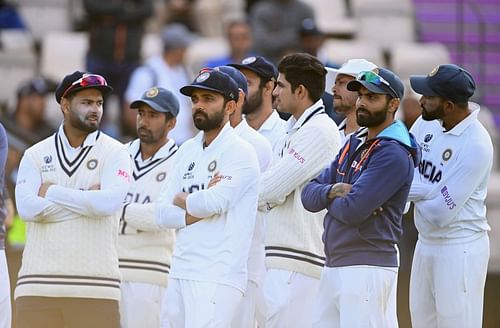
WTC Final: Did India get their playing XI wrong against New Zealand?

Team India went down rather tamely to New Zealand in the World Test Championship (WTC) final at the Ageas Bowl in Southampton. Despite two full days of play being lost in the WTC final, the Black Caps still managed to trounce India by a comprehensive margin of eight wickets.
After being sent into bat under rather challenging conditions, Indian openers Rohit Sharma and Shubman Gill did well to survive against the new ball on Day 1. However, India undid all the hard work, folding up for 217 on the second day, when they should have got somewhere close to 300.
The Indian bowlers led a commendable fightback. However, the age-old problem of being unable to dislodge the tail cheaply persisted as New Zealand took a significant 32-run lead. Virat Kohli’s men then conceded the WTC final on a platter to the Kiwis, getting bowled out for 170 in their second innings.
Was this India's ideal playing combination for the WTC final?
In the wake of India’s lackluster display in the WTC final, one pertinent question that will be raised is - did India get their playing combination for the mega clash right? We analyze and try to arrive at a possible answer.
Siraj should have played over Ishant
Mohammed Siraj or Ishant Sharma? That was the million-dollar question for Team India ahead of the WTC final against New Zealand. India decided to go with the experience of Ishant ahead of Siraj's X-factor. One could understand India’s decision as experience counts for a lot in a big clash like the WTC final. In hindsight though, one has to admit that they got it wrong.
The pitch and conditions in Southampton were tailor-made for swing bowling. India were well aware of this fact in the build up to the WTC final. Yet, their only genuine swing bowler in the squad (Siraj) was not part of the playing XI. Despite their prowess and match-winning ability, the fact that Mohammed Siraj, Jasprit Bumrah and Ishant Sharma are all seam bowlers hurt India, and quite prominently at that.
Consider this. In pace bowling-friendly conditions, Indian captain Virat Kohli needed to turn to off-spinner Ravichandran Ashwin to give the team the breakthrough in both innings. Shami, after an unimpressive start, managed to adjust his length from short to a slightly fuller one and was rewarded with four first-innings wickets.
Ishant and Bumrah, though, clearly struggled for the most part as both failed to swing the ball. Ishant, the most experienced of the Indian pacers, managed to work a way out and finish with three wickets. Bumrah, though, had a Test to forget as he went wicketless, in the WTC final of all occasions.
It is not as if India weren’t given warning signals though. They played with a similar bowling line-up in New Zealand last year and, despite not doing badly, they were definitely outdone by their ‘swing’ counterparts in the opposite camp. Sometimes, picking players based on conditions becomes crucial. But, India did not learn their lessons from the New Zealand tour and repeated the same mistake in the WTC final.
India clearly missed someone like a Bhuvneshwar Kumar
A lot of people were shocked when Bhuvneshwar Kumar was not chosen for the England tour. The reason for doing the rounds was that there were major concerns over his fitness for a long and grueling tour. Point taken.
At the same time, look around Indian cricket, and Bhuvneshwar is the best swing bowler you will find. It was no surprise that queries were being raised over the experienced pace bowler’s exclusion as India’s fast bowlers failed to deliver the goods in the WTC final.
Doesn’t matter that Bhuvneshwar hasn’t played Test cricket since 2018. Considering what was at stake, it was a risk worth taking. Also, due to COVID-19, teams are allowed to travel with a bigger squad. India could definitely have used the opportunity to squeeze in the swing bowler’s name.
Not only did Bhuvneshwar make an impressive comeback in the limited-overs matches against England at home, but he has also tasted success in English conditions. Bhuvneshwar has played five Tests in England, all during the 2014 tour. He claimed 19 wickets in the series at an average of 26.63 with two five-wicket hauls. He also made an impact with the bat, scoring three fifties.
Had Bhuvneshwar been part of the India team for the WTC final, India could have even explored the option of playing four seamers, without weakening their batting too much, as Bhuvneshwar could have batted at the number seven slot.
Even former India captain Sunil Gavaskar backed the popular sentiment that Bhuvneshwar should have played in the WTC final. Gavaskar told Star Sports:
“He (Bhuvneshwar) did play the IPL this time around and there wasn’t any injury concern. He did pull out of the September-October IPL but not this time. I would have included him just for this Test match because it is being played in June."
Gavaskar's view pretty much sums up how India got it all horribly wrong as far as the bowling combination for the WTC final is concerned. They didn’t give themselves the best possible chance to push for victory and paid a heavy price for their miscalculation.